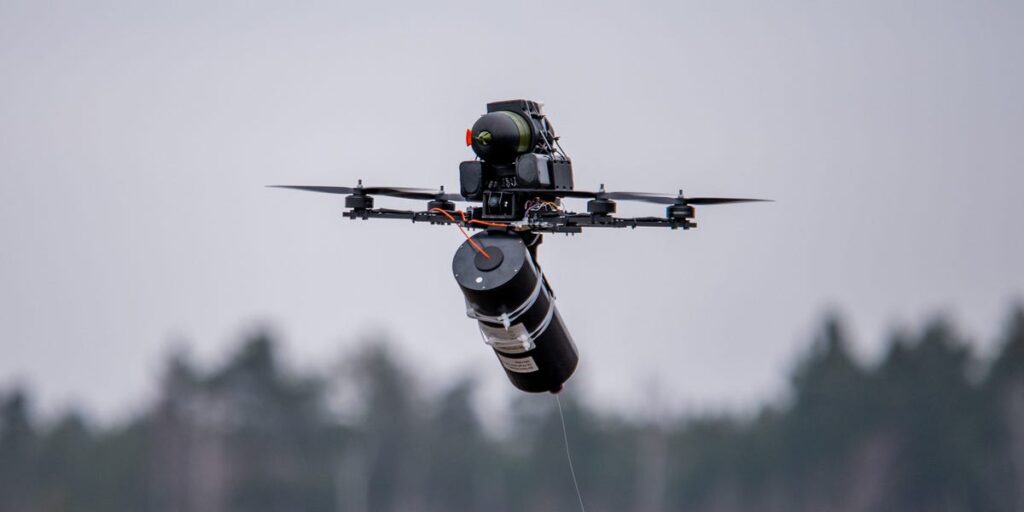A Ukrainian company is developing an unjammable fiber-optic drone that can roam nearly 100 kilometers from its operator — more than doubling the reach of current models — in a bid to radically extend the reach of one of the war’s most feared weapons.
The co-founder of Fold, who asked to only be identified as Volodymyr for security reasons, told Business Insider that the range upgrade is essential as Ukraine races to match a battlefield that shifts by the day and punishes anything that can’t keep up.
“Today, war has changed,” Volodymyr said in emailed remarks. The high-value targets are farther away from the front lines than they used to be, making it imperative that drones have the reach.
Fiber-optic drones are regular first-person-view (FPV) drones — small, commercially available quadcopters that can cost as little as a few hundred dollars and carry a large enough explosive payload to destroy a multimillion-dollar tank.
However, instead of a radio frequency connection between the drone and its operator, fiber-optic drones are fitted with spools of long, thin cables to preserve a steady link. This makes them practically immune to electronic warfare tactics and especially dangerous in combat.
For soldiers, the only real hope of stopping an unjammable drone is with a shotgun. There’s a lot of luck in that kind of defense.
Global Images Ukraine via Getty Images
With no reliable solutions to defend against fiber-optic drones, which can deliver precision strikes, they are emerging as a weapon of choice for Ukraine and Russia. Production is ramping up, and cables are now stretching across the battlefield, glistening in the sun like spider webs, as combat videos have shown.
Fold is one of many Ukrainian companies working on fiber-optic drones for the country’s armed forces. The firm started out building drones with a 5-kilometer range, but has since extended this to 15 and up to 25 kilometers — relatively standard distances.
Volodymyr said this “first generation” of fiber-optic drones was more relevant last year when enemy positions were closer, sometimes even visible with the naked eye, at a distance of several kilometers.
He said the front lines now look different from earlier in the conflict. Opposing troop positions have moved farther away from each other, creating a large gap — or a “gray zone” — that serves as a graveyard for tanks, armored vehicles, and soldiers. Important and expensive military equipment is harder to reach.
“The flight range of 10-15 kilometers is often insufficient to destroy large enemy targets,” Volodymyr said.
He added that fiber-optic drones able to fly beyond 30 kilometers are more relevant at this stage in the war, and Fold is working on these kinds of drones, including some with ranges of 40 and 50 kilometers.
Jose Colon/Anadolu via Getty Images)
Samuel Bendett, a drone expert and an advisor in the Russia studies program at the Center for Naval Analyses, a US research institution, told Business Insider that both Russia and Ukraine are working on 40-kilometer fiber-optic spools, noting “there is evidence at the front that such strikes are already taking place.”
But Fold is aiming farther than this. The company has initiated the research and development process of a second generation of fiber-optic drones, and it plans to launch drones with a range between 50 and 100 kilometers within the next few months.
Bendett said “longer distances are certainly achievable,” but they will depend on the skill of drone pilots and other factors. It is nearly certain, he added, that the ambitious range extensions will come with considerable technical and environmental challenges.
One of the biggest vulnerabilities of fiber-optic drones is their cables, which can get easily snagged or tangled on the battlefield — either through enemy action or accident. The expanded ranges will require much longer coils than previous variants, potentially making drones more susceptible to hang-ups.
An official familiar with warfighting innovations in Ukraine, who spoke to Business Insider on the condition of anonymity to discuss this technology, said that longer cables raise the risk that the drone will encounter more obstacles on its path that could damage it.
The longer cables needed to satisfy the expanded range also add to the drone’s weight, which could force developers to reduce the size of its combat payload, ultimately making the weapon less deadly and reducing its combat effectiveness.
Global Images Ukraine/Global Images Ukraine via Getty Images
The official said the extended-range drones will require larger frames to support the added weight. This could drive up costs and make the drones less nimble on the battlefield.
Volodymyr acknowledges the challenges in fielding this kind of technology. However, there are potential engineering workarounds, and he said the extended range will not compromise the drone’s resistance to electronic warfare, the priority with this tech.
“That is exactly how we made it. This was the main goal of our development (or invention),” he stressed.
It’s unclear whether other Ukrainian companies are trying to expand the range of their drones as far as Fold hopes, but fiber-optic drone manufacturing continues to be a major focus of Kyiv’s defense industry as cheap, uncrewed aerial systems prove their unrelenting dominance on the battlefield.
“Conventional small arms are no longer as relevant as they were in the past,” Volodymyr said. “Shooting from rifles and machine guns is often useless. The bullets simply do not reach the enemy.”
Fiber-optic drones “play a very important role in eliminating attacks (assaults),” he said, referring to Russian mechanized infantry and armored assaults on Ukrainian posts. “They destroy enemy armored vehicles and personnel on distant approaches — tens of kilometers from the positions of the Armed Forces of Ukraine, where small arms cannot reach.”


